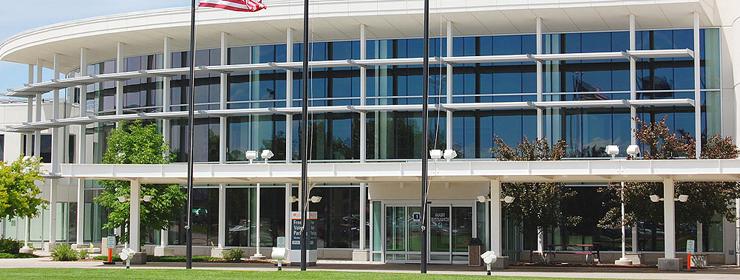
Regional Care Providers Gather for the First Annual Western Nebraska Trauma Symposium
SCOTTSBLUFF, Neb., ― More than 100 medical professionals attended the First Annual Western Nebraska Trauma Symposium Friday, March 24 at Regional West Medical Center.
Attendees from throughout the region, including physicians, providers, nurses, paramedics, EMTs and more, gathered to learn the intricacies of trauma care from experts. Those in attendance represented not only Regional West and its clinics and services, but also several regional care centers that often refer patients to Regional West. Participants had the opportunity to listen to presentations from nine speakers on a variety of subjects related to trauma care.
Facilitator Rommie Hughes, MD, FACS, RPVI, a surgeon with Regional West Physicians Clinic-Surgery, Vascular Diagnostics, said it was important to provide this education to the regional referral providers.
“A lot of people don’t have trauma experience,” Dr. Hughes said, “By having these experts speak, we hope to give them increased ability to care for trauma patients, to try to understand patients who are emergent and non-emergent, and how they can get them to us or other higher levels of care expeditiously.”
Featured topics included Resource Management in the Trauma Bay; Treatment of Head Injuries and Reversal of Anticoagulants; Managing Orthopaedic Injuries Before Transfer; Trauma Imaging and the Use of IV Contrast; Early Resuscitation, Blood, and Blood Products; Calcium Use in Mass Transfusion; Rib Fractures and Rib Plating; Airway Management in the Trauma Patient; and Backboard Use in Trauma. There was also a case study session where trauma scenarios were addressed by a panel of experts.
Jerry McLain, MD, a family physician with Chadron Medical Clinic, has interacted with many of the trauma presenters for the past 20 years, but he said he appreciated the chance to gather more information.
“It impacts how we care for our patients,” Dr. McLain said. “Trauma for us is several times a year, so these conferences are really helpful. A lot of it is kind of a review of things I’ve already done, but I’ve picked up a couple pearls today that I didn’t know.”
Regional West is one of the facilities that was instrumental in beginning the Advanced Trauma Life Support (ATLS) program back in 1977. That program was taken over by the American College of Surgeons in 1980 and has now been taught to more than one million doctors in more than 80 countries around the world. As such, Air Link Flight Director Peter Meyer, MD, said it makes sense for Regional West to offer trauma training in the region.
“I want these providers to feel that they have the knowledge, and this extra training is going to give them the tools to initially stabilize the critically injured patient,” Dr. Meyer said. “They’re doing a great job in these critical access hospitals – rural hospitals – stabilizing people and getting them care. We want to reinforce that and give them more tools to take back and feel confident they can do it.”
As Nebraska’s only Level II Trauma Center west of Kearney, Regional West’s support includes outreach and consultation in the development of trauma services at surrounding facilities. Regional West works closely with the region’s critical access and pre-hospital services, including voluntary basic life support services, ambulance services, and the Air Link flight service. Regional West facilities feature cutting-edge technology and facilities including two dedicated trauma rooms in the Emergency Department, eight operating rooms, a 14-bed critical Intensive Care Unit, and a 24-hour Imaging Services Department.
“I’ve always valued the transfer center setup at Regional West because when I call, I can basically get on the phone with everybody I need to talk to about a trauma patient within the first three minutes without having to rehash my story,” said Cassie Banks, DNP, FNP-C, a nurse practitioner with Gordon Memorial Health Services. “I’ll usually conference with the ER physician, the surgeon, potentially orthopaedics, neurosurgery, and anybody else who needs to be involved. This helps me give the best care while the patient is still at my facility before coming to Regional West. That’s one of my favorite things about the relationship we have with Regional West.”
Banks said she was excited as soon as she saw that the symposium was going to be available.
“To have the degree of experts who have come in to speak at this conference, the number of specialists who are really at the top of their field is great,” Banks said. “Helping us learn how to provide the best care that we can with so many resource limitations is absolutely phenomenal,” Banks said. “And it’s right here at home.”
Zachary Bauman, DO, MHA, FACOS, FACS, the trauma medical director and chest wall injury medical director at the University of Nebraska Medical Center in Omaha and Nebraska’s state trauma director, would like to see more educational opportunities throughout the state.
“I think it’s great that Regional West is doing this and getting this information out to the communities they serve,” Dr. Bauman said. “Coming from Omaha, it’s easy to forget that a lot of our state is Level III, Level IV, critical access hospitals in smaller communities. This is fantastic, but it’s always important to recognize the various challenges this poses when it comes to the management of trauma patients. It’s a fantastic opportunity to bring people together to learn about the challenges and ways we can improve as a state trauma system.”
Regional West Health Services in Scottsbluff, Neb., is the parent company of Regional West Medical Center, a 188-bed regional referral center and the only Level II Trauma Center in Nebraska west of Kearney. As the region’s only tertiary referral medical center, Regional West offers care that spans more than 32 medical specialties provided by over 28 physician clinics. With nearly 300 in-network providers and approximately 2,000 employees, Regional West provides comprehensive and innovative health care services for the people of western Nebraska and the neighboring states of Colorado, South Dakota, and Wyoming.